Tags
Adolf le Comte, Art Nouveau Interior, Co Breman, Jan Hendrik Tromp Meesters, Jan Schouten, Johan Godart van Gendt, Jugendstil, Karel Cramer, Vereniging Hendrick de Keyser, Villa Rams Woerthe, Willem Bogtman
Excellent news: the first Art Nouveau House Museum is about to be opened in The Netherlands! From the 3rd of December 2017, Villa Rams Woerthe will officially be open to visitors. The house was commissioned in 1899 by Jan Hendrik Tromp Meesters, a Dutch entrepreneur, philanthropist en politician. In 2015, it was obtained by Vereniging Hendrick de Keyser, a historic houses association in The Netherlands. This association aims to be a guardian of the architectural heritage of The Netherlands by acquiring, conserving, restoring and renting out historic properties. And it may only be my humble opinion, but I think this museum proofs they are doing an excellent job!
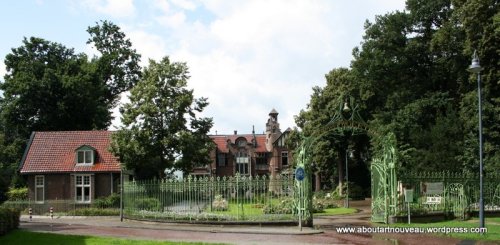
In August, I got a preview of the house and its breathtaking interior. My private guide was the lovely mrs. Cock Brouwer who has worked in the building for nearly two decades and knew the house like the back of her hand. Unfortunately, it was a rainy day, so excuse the dark nature of my photographs… they do this beautiful place no justice. I strongly suggest you visit the museum in person to enjoy the real splendor of its appearance.
Architectural Design Competition
When Salco Tromp Meesters died in 1895, his sons Jan and Jan Hendrik Tromp Meesters inherited millions and a thriving sawmill. With their newly acquired fortune Jan built the rather conservative ‘Villa Nijenstede’ for his family while Jan Hendrik must have wanted to outshine his brother by building his ‘Villa Rams Woerthe’ according to the latest trends.
Jan Hendrik Tromp Meesters (1855-1908) organised a design competition for his dream house and chose the famous Amsterdam architect Adolf L. van Gendt (1835-1901) to realise his dream. Van Gendt came from a family of architects, and from the early 1890s also his sons Johan Godart (1866-1925) and Adolf Daniël Nicolaas (1870-1932) joined their father in the family business. According to Valentijn Carbo, the historian of Vereniging Hendrick de Keyser, it is very likely that the actual designer of Rams Woerthe was Johan Godart: during recent restoration works, a charter was discovered that had been immured when the first stone was laid. The charter mentioned the names of Johan Godart van Gendt and his wife. The name of his father was nót mentioned. Moreover, we know from Johan Godart that he was actively involved in the construction of villa’s. A few years earlier for instance, he designed Villa Henriëtte in Hilversum, which is in many ways a sister of Villa Rams Woerthe.
Villa Rams Woerthe
Let me first explain the name of the villa, Rams Woerthe, because even for Dutch people it is a funny name. The villa and gardens were built on grasslands outside the village of Steenwijk. Apparently, ‘woerthe’ is an old word meaning ‘meadow’. And ‘Ram’ was the name of a mayor who owned that meadow hundreds of years earlier.
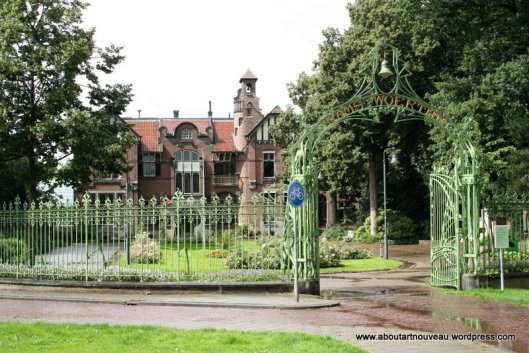
The plan reveals an English influence: around a central hall, in which a monumental staircase is housed, are the salon, the dining room, the living room and the smoking room. This is a typical feature of Art Nouveau houses, as architects wanted every room to have direct access to daylight. When in 1899 Jan Hendrik Tromp Meesters and his wife Anna Catherina Fresemann Viëtor moved in with their children, they had roughly spent fl.70.000,- (€35.000 nowadays) on the build of their ‘castle’.
But they didn’t leave it at that. Jan Hendrik clearly wanted his family home to be the best of the best. Skilled craftsmen from Spain and Italy were reeled in to create the ceilings and ornaments. And really, I have visited several house museums in Barcelona, the similarity of the ornamentation is striking. Monkey’s, owls, lizards and panter-like creatures, they are all there! Interesting to know is that only during renovations in 1995 it was discovered that the decorated ceilings were made from paper mache.
In the grand hall, on the mantle of the fireplace, we can still see the coat of arms of the family. It includes a detail of the coat of arms of the town of Steenwijk: an anchor.
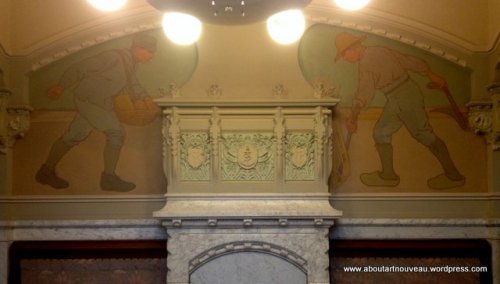
The entrance and staircase were decorated by decorative painter Ahazueros Jacobus Breman, a.k.a. Co Breman with agricultural representations: grain fields, sowing, ploughing, harvesting, processing the grain, baking bread etc. At the time, Breman created 2 other massive decorations. But this one at Rams Woerthe, covering two floors, is the only one that survived.
The spectacular wrought iron gate and fence around the villa were designed by Karel Cramer, the artistic designer who was also responsible for its execution at Koninklijke Fabriek F.W. Braat in Delft.
Unfortunately, Jan Hendrik didn’t get to spend many years at Rams Woerthe. He died way too early, at age 53, in September 1908. His wife and 5 children moved back to their old family home as the villa was to big for them. The first years, they had enough money to maintain their standard. But Jan Hendrik had invested most of his money in Russia and when the Russian Revolution started in 1917, their capital vanished like frost under the morning sun. Anna Maria had to sell the beautiful Rams Woerthe…
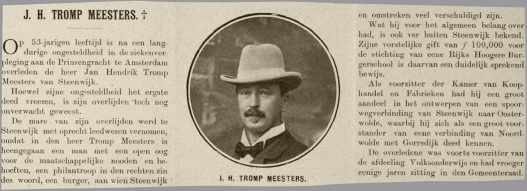
The original Art Nouveau furniture was stored in Arnhem where it got bombed during the second World War. Everything was burned. So this photo is probably the only evidence we will ever have of the original interior of the house. Isn’t it gorgeous?!?
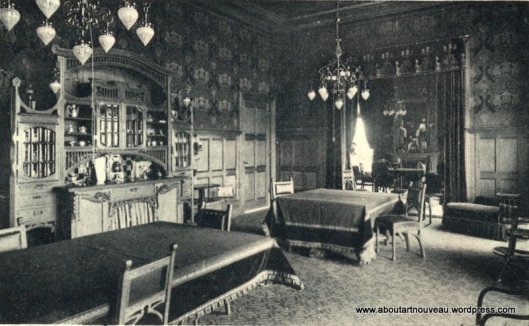
The villa was bought by the town of Steenwijk, and served as its town hall until 1992. The bedrooms upstairs were transformed into offices. But the beautiful salon, dining- and livingroom roughly remained in their original state. They served among other things as the towns wedding hall.
The beautiful stained glass windows of the central hall – depicting Spring – were designed by Adolf le Comte, designer at the Porceleyne Fles in Delft since 1880. They were produced at the atelier of Jan Schouten, and installed between 1919 and 1922 when the villa already served as town hall. Later, in 1926, stained-glass windows by Willem Bogtman were installed at the first floor as a gift from board member D.H. Wicherson to celebrate his 70th birthday. They include the coat of arms of the town of Steenwijk (St. Clemens), with on the left the coat of arms of the province of Overijssel, and on the right the coat of arms of The Netherlands (lion). But we can also find stained and leaded glass by Jan Schouten in the salon and the dining room. It’s basically everywhere!
Vereniging Hendrick de Keyser has recently called for people who got married at the villa, to submit their wedding pictures. A wedding album with photo’s covering 100 years will be shown at the museum. What a lovely idea… Good news is that the museum will continue to serve as a wedding venue! Vereniging Hendrick de Keyser also arranged for period correct furniture from the depots of other museums and of the Cultural Heritage Agency of the Netherlands to be displayed at Rams Woerthe. The bedrooms that were severely altered in the past will not be part of the museum; they will be rented out as offices generating extra income for maintenance of the museum. The Hildo Krop Museum that previously housed in the villa will remain in the villa. Their collection will be displayed in the basement.
Some more Art Nouveau details
I would like to end my post with a few pictures of details. Details from area’s where the public is allowed as well as details from area’s where the public is nót allowed… I loved the simple room for the maids under the roof. And how about that beautiful balcony? I can almost see the kids being tutored there during a warm summer’s day… a breeze slowly moves the veils hanging from the framework… just a few more minutes… coming downstairs with me? Tea will be served in the salon…
Villa Rams Woerthe – Gasthuislaan 2
8331 MX Steenwijk – The Netherlands
Read more
Architectenbureau Van Gendt via amsterdamsebinnenstad.nl
Funda real estate
Koninklijke Fabriek F.W. Braat
Het begin van Rams Woerthe – de aankoop van de grond
Monumentaal.nl
Radio interview: Museumhuis gaat open in Rams Woerthe
Website Villa Rams Woerthe (currently offline)
Wikipage Jan Hendrik Tromp Meesters
Wikipage Villa Rams Woerthe
Vereniging Hendrick de Keyser
Vereniging Hendrick de Keyser about the museum
Villa Henriëtte, Hilversum























































Great post and great pictures, as usual!
But there’s one thing I don’t understand: hasn’t this villa been already open to visitors for years as the sculptor Hildo Krop museum (http://hildokrop.nl/bezoekersinfo)? Has that museum moved out and left the space as a pure Art Nouveau experience? If so, I wish the same happened to Gorky Museum in Moscow, hosted in the magnificent Ryabushinsky House – 99% of visitors coming to that museum come for Art Nouveau architecture and interiors and not for Gorky who lived in the house for a few years and hated it… The house would have made a world class Art Nouveau museum which Moscow is glaringly misssing.
LikeLiked by 1 person
Hi Andrei, thank you for your kind words! And thank you for letting me know how I can improve my post. I have now tried to make it more clear in the text. The Hildo Krop museum is indeed located in the same villa, but their display will be limited to the basement, from what I understood. The current owner of the building has period correct furniture on loan from the depots of other museums and the Cultural Heritage Agency. So the house now really is a ‘house museum’. The intention is that visitors can ‘feel’ how people used to live in the house back in 1900. You may even sit down on the furniture and pour yourself a cup of tea in the salon! I hope that answers your questions?
LikeLike
Thanks for the explanation – it’s clear now!
LikeLike
Hello Olga, great pictures and films. I was there some 30 years ago and can see the building and interior is still in good condition. Now as a museum with the furniture it will look even better and I will soon visit it again. As you probably know some people in THE HAGUE want to start an ART NOUVEAU museum in the LORRIE HOUSE that is for sale. The house is in art nouveau style and built by the builder/architect Lorrie for his own housing and still owned by descendants. Great grandson Bart Bonarius restored the house completely. The original furniture is still there. Fred Westen, The Hague.
LikeLike
Hi Fred, thank you for your compliments. I hope you will enjoy the museum when you revisit the villa. About the situation in The Hague, I am fully aware of it. They are keeping me in the loop. Let’s hope they can get that museum up and running as well!
LikeLike
I will have to find a way to visit this wonderful building now
LikeLike
Hello, I have a question. Why use Spanish, Italian craftsmen? Instead of French or British craftsmen? Thanks very much. New Year’s greetings.
LikeLike
Because they were considered the experts in plastering. They still are…
LikeLike
Hello, thank you very much for your reply. I have benefited a lot.
Good wishes
LikeLike
Dear webmaster,
It’s really a pity the restorer of Villa Ramswoerthe is not mentioned: Randolph Algera of Art-Decor (1994) He restored the 14 paintings of Co Breman and he restored also the whole interior of the Jugenstil Villa Rams Woerthe. For this ‘gesamtkunstwerk’ he received the 1st Prize of the Dutch Painters Artists Prize in 2013. Rarely one finds such a high standard (juryreport)
He would like you to publish links to his sites below the article. He earns the credits, don’t you think? Years of craftsmanship!
http://www.art-decor.nl
http://www.art-decor.nl/totaalconcepten-historische-interieurs/totaalconcepten-historische-interieurs/
LikeLike